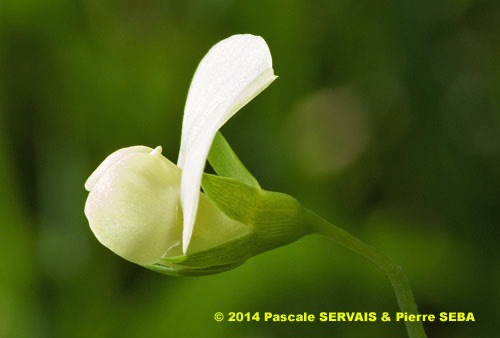
Lathyrus aphaca L.
Fam. : Fabaceae
© Pascale SERVAIS & Pierre SEBA, 2018. Tilo Botanica: Flore de Tilos et du Dodécanèse / Flora of Tilos and of the Dodecanese
English translation by Brenda Bradbury, Howard Bradbury and Stéphane Léonard
Plante herbacée, hermaphrodite, étalée ou grimpante, à tiges quadrangulaires, non ailées, glabres.
Feuilles inexistantes, à vrille simple partant de la base des stipules. Stipules vertes, entières, sans pétiole, ressemblant à des feuilles, glabres, ovales à base cordiforme, larges, de 6 à 25 mm de large et de 10 à 30 mm de long.
Fleurs à symétrie bilatérale, jaunes à jaune pâle, unies, à étendard parfois veiné de noir, de 6 à 15 mm de long, solitaires ou par 2, portées par un pédoncule plus long que la fleur et que les stipules. Corolle papilionacée, dépassant peu le calice. Calice à 5 dents presque égales, sans bosse à la base, 3 fois plus longues que le tube. Ovaire supère.
Fruits, gousses droites à légèrement arquées comme un sabre, aplaties, lisses, brunes devenant jaunâtres à maturité, glabres, de 20 à 35 mm de long, d’environ 6 mm de large, à 4 à 8 graines saillantes.
___________________________
Plant herbaceous, hermaphrodite, spread out or climbing. Stems quadrangular, nonwinged, glabrous.
Leaves non-existent, with a simple tendril proceeding from the base of the stipules. Stipules green, entire, without a petiole, resembling leaves, glabrous, ovate with a heart-shaped base, wide, from 6 to 25 mm across and 10 to 30 mm long.
Flowers bilaterally symmetrical, yellow to pale yellow, self-coloured, sometimes with black veins on the standard, from 6 to 15 mm long, solitary or by 2, carried by a peduncle longer than the flower and the stipules. Corolla papilionaceous, scarcely exceeding the calyx. Calyx with 5 almost equal teeth, without a bump at the base, 3 times longer than the tube. Ovary superior.
Fruits, pods straight to slightly arched like a sabre, flattened, smooth, brown becoming yellowish at maturity, glabrous, from 20 to 35 mm long, approximately 6 mm across, with 4 to 8 protruding seeds.
Descripteurs / Identifying features
1
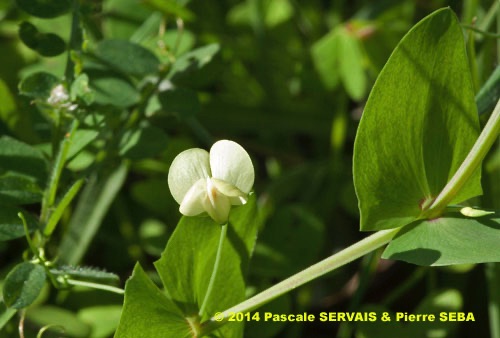
2
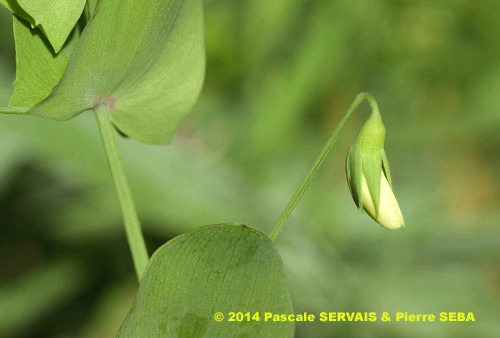
3
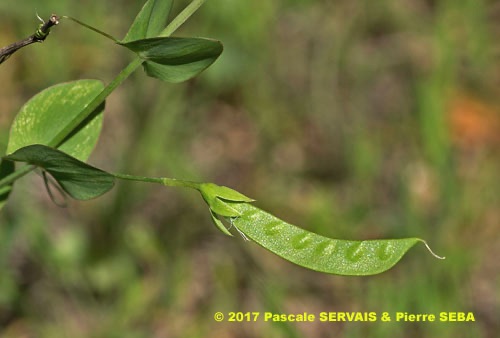
4
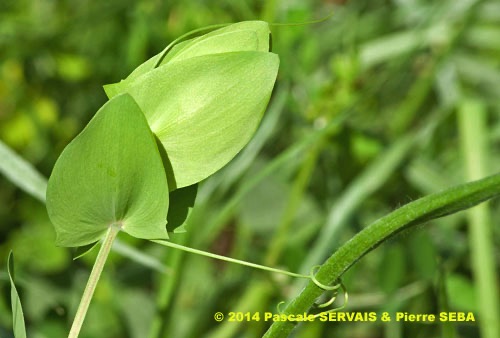
5
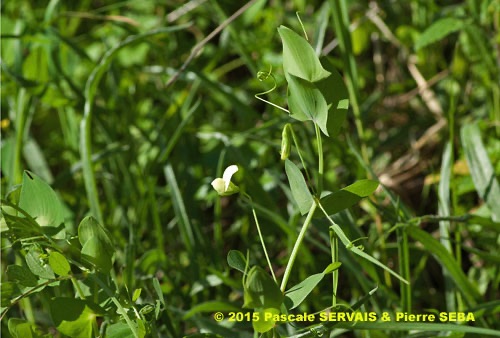
6
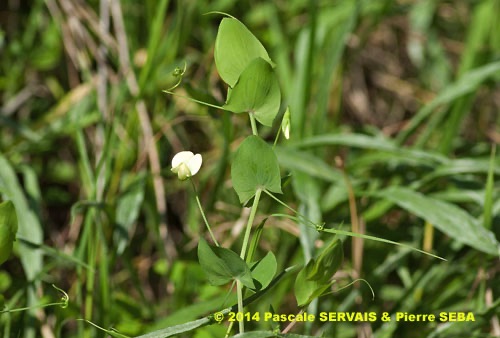
7
Étymologie / Etymology :
Lathyrus : emprunt du grec ancien λάθυρος, -ου (nom) = le pois chiche,
nom donné à la plante par Théophraste, philosophe péripatéticien,
disciple d’Aristote, botaniste et naturaliste, mort vers 288 av. J.-C.
Aphaca : emprunt du grec ancien ἀφάκη, -ης (nom) = sorte de gesse.
Lathyrus : borrowed from Classical Greek λάθυρος, -ου (noun)
= chickpea, name given to the plant by Theophrastus, peripatetic
philosopher, disciple of Aristotle, botanist and naturalist, died
towards 288 BC.
Aphaca : borrowed from Classical Greek ἀφάκη, -ης (noun) = kind
of grass pea.
Synonymes / Synonyms :
Aphaca vulgaris C.Presl
Lathyrus aphyllus Gray
Lathyrus filipetiolatus St.-Lag.
Lathyrus floribundus Velen.
Lathyrus polyanthus Boiss. & Blanche
Lathyrus pseudoaphaca Boiss.
Lathyrus segetum Lam.
Orobus aphaca (L.) Döll
Vicia exstipulata S.G.Gmel.
Noms vernaculaires / Common names :
Noms français / French names :
Gesse aphaca — Gesse aphylle — Gesse sans feuilles — Lisette —
Poigreau — Pois aux lièvres — Pois-de-serpent — Reluiseau.
Noms grecs / Greek names :
Αγριολαθούρι — Αγριολαθούρι κοινό — Αγριολαθουριά —
Κίτρινο λαθούρι — Κοινό αγριολαθούρι.
Noms anglais / English names :
Bindweed — Tare — Yellow pea — Yellow vetchling —
Yellow-flowered pea.
Noms allemands / German names :
Acker-Platterbse — Nackte Platterbse — Ranken-Platterbse —
Rankenplatterbse — Spaten-Platterbse.
Noms espagnols / Spanish names :
Afaca — Alverja amarilla — Alverja silvestre —
Arveja de burros — Basillón.
Noms italiens / Italian names :
Afaga — Cicerchia bastarda — Cicerchia senza foglie —
Fior galletto — Majorella — Mullaghera — Pitine —
Veccia-bastarda — Veccia-lustra — Veccia-sterile.
Habitat :
Forêts - Cultures - Lieux pierreux - Lieux incultes - Chemins -
Haies, fourrés, broussailles.
Forests - Cultivated places - Stony places - Waste ground -
Waysides - Hedges, thickets.
Île / Island :
Tilos.
Hauteur / Height range :
De 30 cm à 1 m.
From 30 cm to 1 m.
Floraison / Flowering time :
De janvier à juin.
From January to June.
Groupe / Classification :
Dicotylédones.
Dicotyledons.
Pérennité / Lifespan :
Annuelle.
Annual.
Description :
Clés dichotomiques et descripteurs distinctifs des 6 espèces / Dichotomous keys and distinctive identifying features of the 6 species
Photo 1 :
Localisation / Location : Tilos, Megalochorio, Plaine d’Erystos
Date : 09/02/2014
GPS : Lat. 36,44414° N / Long. 27,34918° E / Alt. 26 m
Type : Photographie numérique / Digital Photograph (10 mégapixels)
Photo 2 :
Localisation / Location : Tilos, Megalochorio, Plaine d’Erystos
Date : 09/02/2014
GPS : Lat. 36,44414° N / Long. 27,34918° E / Alt. 26 m
Type : Photographie numérique / Digital Photograph (10 mégapixels)
Photo 3 :
Localisation / Location : Tilos, Megalochorio, Plaine d’Erystos
Date : 09/02/2014
GPS : Lat. 36,44414° N / Long. 27,34918° E / Alt. 26 m
Type : Photographie numérique / Digital Photograph (10 mégapixels)
Photo 4 :
Localisation / Location : Tilos, Megalochorio, Plaine d’Erystos
Date : 26/03/2017
GPS : Lat. 36,44731° N / Long. 27,34474° E / Alt. 34 m
Type : Photographie numérique / Digital Photograph (24 mégapixels)
Photo 5 :
Localisation / Location : Tilos, Megalochorio, Plaine d’Erystos
Date : 09/02/2014
GPS : Lat. 36,44414° N / Long. 27,34918° E / Alt. 26 m
Type : Photographie numérique / Digital Photograph (10 mégapixels)
Photo 6 :
Localisation / Location : Tilos, Megalochorio, Plaine d’Erystos
Date : 09/02/2014
GPS : Lat. 36,44414° N / Long. 27,34918° E / Alt. 26 m
Type : Photographie numérique / Digital Photograph (10 mégapixels)
Photo 7 :
Localisation / Location : Tilos, Megalochorio, Plaine d’Erystos
Date : 09/02/2014
GPS : Lat. 36,44414° N / Long. 27,34918° E / Alt. 26 m
Type : Photographie numérique / Digital Photograph (10 mégapixels)

Google Maps
Google Maps
Google Maps
Google Maps
Google Maps
Google Maps
Google Maps